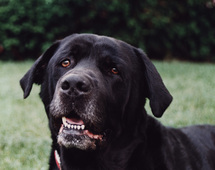 Major, the "bull in a China shop"
Major, the "bull in a China shop" As we know from prior discussions, cruciate injuries are extremely common in our canine friends. A complete cruciate tear causes instability in the affected stifle (knee.) What you see as an owner is that your dog doesn’t want to put full weight, or in some cases, any weight on the leg with injury. In people, we know that this instability leaves them with a“giving way” sensation, creating a lack of trust that the knee will support them. This is likely true for your dog with the injured stifle, too. We know that there are many receptors in joints that provide information to your brain about where your body is in space. We call this body awareness or proprioception. Injuries to a joint create swelling, inflammation and this alters this body awareness. Longterm fibrosis or scar tissue affects it too. This altered awareness can increase the risk of additional injury.
One of our goals in physical rehabilitation is to improve this body awareness and proprioception when there is an injury to a joint, as in an ACL tear, to help prevent further injury. We want to enhance balance and improve body awareness. One of the best ways to do this is to provide sensory input in a controlled, but unstable, environment. Think balance disc here. BOSU ball. Peanut ball. Wobbleboard. Exercises that provide an element of instability are fabulous choices to enhance body awareness. The trick is doing these therapeutic exercises in a carefully controlled manner with supervision. Like anything new, your dog must learn what we want him to do and then his body must learn how to do it. Some dogs are more aware than others. I think we have all seen those dogs that are like the proverbial "bull in a china shop." My first dog, Major, was like that. If I had known then what I know now, I would have worked with him to improve that.Every dog has the ability to improve to maximize their potential.
Ultimately, working on proprioception is about safety. The exercise must be done safely, watching your dog's form and watching for signs of muscle fatigue,(which is when your dog is at increased risk for injury.) We want to safely increase body awareness to reduce your dog's level of risk for further injury.

 RSS Feed
RSS Feed